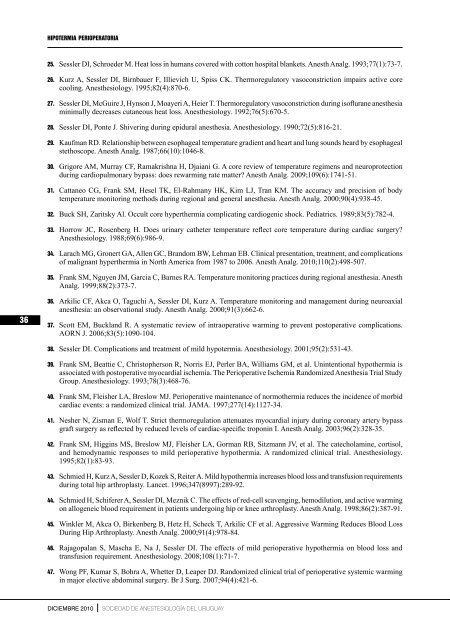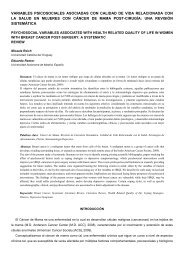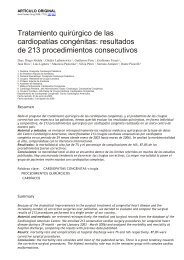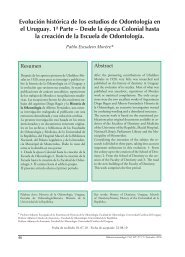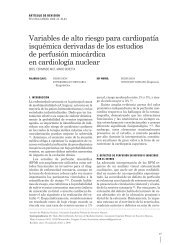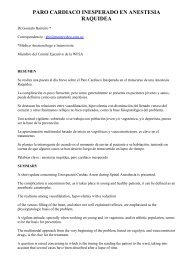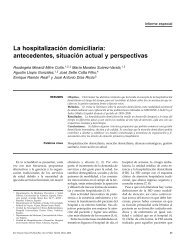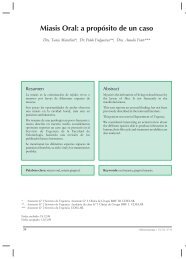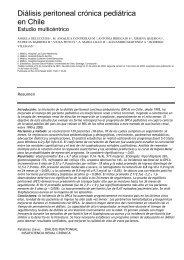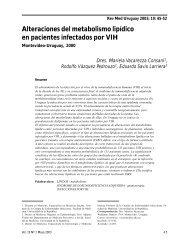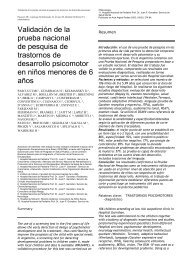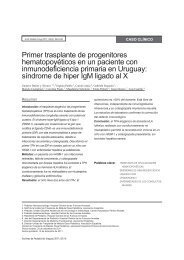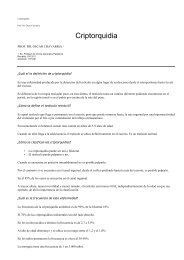ANESTESIA ANALGESIA REANIMACIÃN - SciELO
ANESTESIA ANALGESIA REANIMACIÃN - SciELO
ANESTESIA ANALGESIA REANIMACIÃN - SciELO
You also want an ePaper? Increase the reach of your titles
YUMPU automatically turns print PDFs into web optimized ePapers that Google loves.
hipotermia perioperatoria<br />
dr. william baptista, dra. karina rando, dra. graciela zunini<br />
25. Sessler DI, Schroeder M. Heat loss in humans covered with cotton hospital blankets. Anesth Analg. 1993;77(1):73-7.<br />
26. Kurz A, Sessler DI, Birnbauer F, Illievich U, Spiss CK. Thermoregulatory vasoconstriction impairs active core<br />
cooling. Anesthesiology. 1995;82(4):870-6.<br />
27. Sessler DI, McGuire J, Hynson J, Moayeri A, Heier T. Thermoregulatory vasoconstriction during isoflurane anesthesia<br />
minimally decreases cutaneous heat loss. Anesthesiology. 1992;76(5):670-5.<br />
28. Sessler DI, Ponte J. Shivering during epidural anesthesia. Anesthesiology. 1990;72(5):816-21.<br />
29. Kaufman RD. Relationship between esophageal temperature gradient and heart and lung sounds heard by esophageal<br />
stethoscope. Anesth Analg. 1987;66(10):1046-8.<br />
30. Grigore AM, Murray CF, Ramakrishna H, Djaiani G. A core review of temperature regimens and neuroprotection<br />
during cardiopulmonary bypass: does rewarming rate matter? Anesth Analg. 2009;109(6):1741-51.<br />
31. Cattaneo CG, Frank SM, Hesel TK, El-Rahmany HK, Kim LJ, Tran KM. The accuracy and precision of body<br />
temperature monitoring methods during regional and general anesthesia. Anesth Analg. 2000;90(4):938-45.<br />
32. Buck SH, Zaritsky Al. Occult core hyperthermia complicating cardiogenic shock. Pediatrics. 1989;83(5):782-4.<br />
48. Valeri CR, Cassidy G, Khuri S, Feingold H, Ragno G, Altschule MD. Hypothermia-induced reversible platelet<br />
dysfunction. Ann Surg. 1987;205(2):175-81.<br />
49. Cavallini M, Baruffaldi, Preis FW, Casati A. Effects of mild hypothermia on blood coagulation in patients undergoing<br />
elective plastic surgery. Plast Reconstr Surg. 2005;116(1):316-21.<br />
50. Sessler DI, Olofsson CI, Rubinstein EH, Beebe JJ. The thermoregulatory threshold in humans during halothane<br />
anesthesia. Anesthesiology. 1988;68(6):836-42.<br />
51. Hopf HV, Hunt TK, West JM. Wound tissue oxygen tension predicts the risk of wound infection in surgical patients.<br />
Arch Surg. 1997;132(9):997-1004.<br />
52. Sessler DI, Olofsson CI, Rubinstein EH. The thermoregulatory threshold in humans during nitrous oxide-fentanyl<br />
anesthesia. Anesthesiology. 1988;69(3):357-64.<br />
53. Wenisch C, Narzt E, Sessler DI, Parschalk B, Lenhardt R, Kurz A, et al. Mild intraoperative hypothermia reduces<br />
production of reactive oxygen intermediates by polymorphonuclear leukocytes. Anesth Analg. 1996;82(4):810-6.<br />
54. Beilin B, Shavit Y, Razumovsky J, Wolloch Y, Zeidel A, Bessler H. Effects of mild perioperative hypothermia on<br />
cellular immune responses. Anesthesiology. 1998;89(5):1133-40.<br />
33. Horrow JC, Rosenberg H. Does urinary catheter temperature reflect core temperature during cardiac surgery?<br />
Anesthesiology. 1988;69(6):986-9.<br />
55. Kurz A, Sessler DI, Lenhardt R. Study of Wound Infections and Temperature Group: Perioperative normothermia to<br />
reduce the incidence of surgical-wound infections and shorten hospitalization. N Engl J Med. 1996;334(19):1209-15.<br />
34. Larach MG, Gronert GA, Allen GC, Brandom BW, Lehman EB. Clinical presentation, treatment, and complications<br />
of malignant hyperthermia in North America from 1987 to 2006. Anesth Analg. 2010;110(2):498-507.<br />
56. Melling AC, Ali B, Scott EM, Leaper DJ. Effects of preoperative warming on the incidence of wound infection after<br />
clean surgery: a randomised controlled trial. Lancet. 2001;358(4):876-80.<br />
35. Frank SM, Nguyen JM, Garcia C, Barnes RA. Temperature monitoring practices during regional anesthesia. Anesth<br />
Analg. 1999;88(2):373-7.<br />
57. Heier T, Caldwell JE, Sessler DI, Miller RD. Mild intraoperative hypothermia increases duration of action and spontaneous<br />
recovery of vecuronium blockade during nitrous oxide-isoflurane anesthesia in humans. Anesthesiology. 1991;74(5):815-9.<br />
36<br />
36. Arkilic CF, Akca O, Taguchi A, Sessler DI, Kurz A. Temperature monitoring and management during neuroaxial<br />
anesthesia: an observational study. Anesth Analg. 2000;91(3):662-6.<br />
37. Scott EM, Buckland R. A systematic review of intraoperative warming to prevent postoperative complications.<br />
AORN J. 2006;83(5):1090-104.<br />
58. Heier T, Caldwell JE, Sharma ML, Gruenke LD, Miller RD. Mild intraoperative hypothermia does not change the<br />
pharmacodynamics (concentration-effect relationship) of vecuronium in humans. Anesth Analg. 1994;78(5):973-7.<br />
59. Leslie K, Sessler DI, Bjorksten AR, Moayeri A. Mild hypothermia alters propofol pharmacokinetics and increases<br />
the duration of action of atracurium. Anesth Analg. 1995;80(5):1007-14.<br />
37<br />
38. Sessler DI. Complications and treatment of mild hypotermia. Anesthesiology. 2001;95(2):531-43.<br />
39. Frank SM, Beattie C, Christopherson R, Norris EJ, Perler BA, Williams GM, et al. Unintentional hypothermia is<br />
associated with postoperative myocardial ischemia. The Perioperative Ischemia Randomized Anesthesia Trial Study<br />
Group. Anesthesiology. 1993;78(3):468-76.<br />
60. Smeulers NJ, Wierda JM, van den Broek L, Gallandat Huet RC, Hennis PJ. Effects of hypothermic cardiopulmonary<br />
bypass on the pharmacodynamics and pharmacokinetics of rocuronium. J Cardiothorac Vasc Anesth. 1995;9(6):700-5.<br />
61. Eger EI, 2nd, Johnson BH. MAC of I-653 in rats, including a test of the effect of body temperature and anesthetic<br />
duration. Anesth Analg. 1987;66(10):974-6.<br />
40. Frank SM, Fleisher LA, Breslow MJ. Perioperative maintenance of normothermia reduces the incidence of morbid<br />
cardiac events: a randomized clinical trial. JAMA. 1997;277(14):1127-34.<br />
41. Nesher N, Zisman E, Wolf T. Strict thermoregulation attenuates myocardial injury during coronary artery bypass<br />
graft surgery as reflected by reduced levels of cardiac-specific troponin I. Anesth Analg. 2003;96(2):328-35.<br />
42. Frank SM, Higgins MS, Breslow MJ, Fleisher LA, Gorman RB, Sitzmann JV, et al. The catecholamine, cortisol,<br />
and hemodynamic responses to mild perioperative hypothermia. A randomized clinical trial. Anesthesiology.<br />
1995;82(1):83-93.<br />
43. Schmied H, Kurz A, Sessler D, Kozek S, Reiter A. Mild hypothermia increases blood loss and transfusion requirements<br />
during total hip arthroplasty. Lancet. 1996;347(8997):289-92.<br />
44. Schmied H, Schiferer A, Sessler DI, Meznik C. The effects of red-cell scavenging, hemodilution, and active warming<br />
on allogeneic blood requirement in patients undergoing hip or knee arthroplasty. Anesth Analg. 1998;86(2):387-91.<br />
45. Winkler M, Akca O, Birkenberg B, Hetz H, Scheck T, Arkilic CF et al. Aggressive Warming Reduces Blood Loss<br />
During Hip Arthroplasty. Anesth Analg. 2000;91(4):978-84.<br />
46. Rajagopalan S, Mascha E, Na J, Sessler DI. The effects of mild perioperative hypothermia on blood loss and<br />
transfusion requirement. Anesthesiology. 2008;108(1):71-7.<br />
47. Wong PF, Kumar S, Bohra A, Whetter D, Leaper DJ. Randomized clinical trial of perioperative systemic warming<br />
in major elective abdominal surgery. Br J Surg. 2007;94(4):421-6.<br />
62. Antognini JF. Hypothermia eliminates isoflurane requirements at 20 ºC. Anesthesiology. 1993;78(6):1152-6.<br />
63. Lenhardt R, Marker E, Goll V, Tschernich H, Kurz A, Sessler DI et al. Mild intraoperative hypothermia prolongs<br />
postoperative recovery. Anesthesiology. 1997;87(6):1318-23.<br />
64. Kurz A, Sessler DI, Narzt E, Bekar A, Lenhardt R, Huemer G et al. Postoperative hemodynamic and thermoregulatory<br />
consequences of intraoperative core hypothermia. J Clin Anesth. 1995;7(5):359-66.<br />
65. Cheng C, Matsukawa T, Sessler DI, Kurz A, Merrifield B, Lin H et al. Increasing mean skin temperature linearly reduces<br />
the core temperature thresholds for vasoconstriction and shivering in humans. Anesthesiology. 1995;82(5):1160-8.<br />
66. Lopez M, Sessler DI, Walter K. Rate and gender dependence of the sweating, vasoconstriction, and shivering<br />
thresholds in humans. Anesthesiology. 1994;80(4):780-8.<br />
67. Wyss CR, Brengelmann GL, Johnson JM, Rowell LB, Silverstein D. Altered control of skin blood flow at high skin<br />
and core temperatures. J Appl Physiol. 1975;38(5):839-45..<br />
68. Just B, Treïvien V, Delva E, Lienhart. Prevention of intraoperative hypothermia by preoperative skin-surface warming.<br />
Anesthesiology. 1993;79(2):214-8.<br />
69. Glosten B, Hynson J, Sessler DI, McGuire J. Preanesthetic skin-surface warming reduces redistribution hypothermia<br />
caused by epidural block. Anesth Analg. 1993;77(3):488-93.<br />
70. Horn EP, Schroeder F, Gottschalk A, Sessler DI, Hiltmeyer N, Standl T et al. Active warming during cesarean<br />
delivery. Anesth Analg. 2002;94(2):409-14.<br />
diciembre 2010 ❘ sociedad de anestesiología del uruguay<br />
sociedad de anestesiología del uruguay ❘ diciembre 2010


